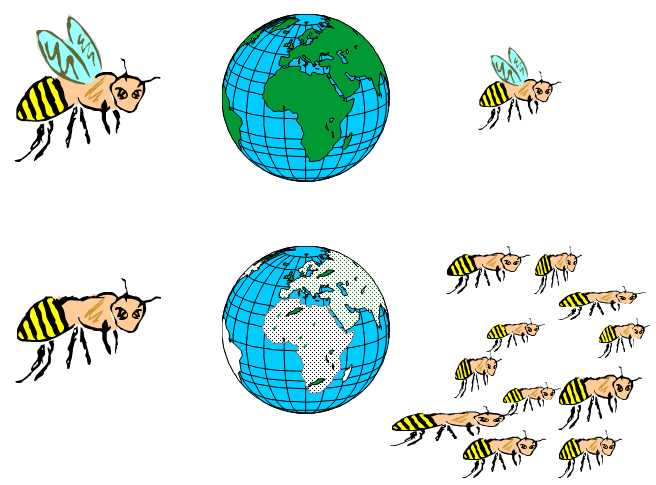XXVI.2.2 Anagenetic change can also affect cladogenesis by directly modifying the likelihood of speciations or extinctions
The second way in which an anagenetic change can affect cladogenesis is through a direct effect on the probability of speciation or extinction of the species.A change in the phenotype that would substantially affect any of these processes need not greatly affect the ecological niche of the species or the fitness of an individual.Simultaneously, both these properties can affect the probability of speciation and extinction.These can be either traits borne directly by individual members of the population or emergent traits, i.e. properties borne by individual populations or species, but not by individuals.
The first category of these changes includes, for example, the emergency or disappearance of functional wings that, on the one hand, allow a species to occupy more distant locations but, on the other hand, complicate differentiation of the gene pools of its local populations and thus reduce the probability of peripatric speciation (Fig. XXVI.5) .Speciation within some taxa can substantially

Fig. XXVI.5 Anagenetic change increasing the probability of speciation. If the motility is reduced in a species, e.g. because of the loss of wings, this can be manifested in that, instead of one genetically interconnected and thus genetically uniform population (a), the species forms a mosaic of small populations occupying small isolated territories (b). However, this increases the chance that this species will split off a greater number of daughter species. While the individual daughter species will become extinct more readily than the cosmopolitan winged species, the extinction of the individual species will not mean the extinction of the entire phylogenetic line. Thus, over time, the progeny of the wingless species could predominate in nature, even if it is at a disadvantage in direct ecological competition with the winged species.
accelerate the transition to a parasitic life style.In arthropods, the transition to a parasitic or parasitoid life style is accompanied by greater probability of infection by parasitic bacteria of the Wolbachia genus as, for multiple infection of a single host, parasitic bacteria can also be transferred between different species (Vavre et al. 1999).As was described in the chapter on speciation, these infections can become an important motor for speciation in their host species and better conditions for spreading for parasitoids could explain the large number of species with this life style (see XXI.5.4).Similarly, the transition of plants to entomophily and the related sexual selection mediated by pollinators cam also be an important motor for speciation.Once again, this can explain why entomophilous plants form taxa with more species than anemophilous plants (Dodd, Silvertown, & Chase 1999).
The probability of extinction of a species can be affected, for example, by transition to a planktonic life style.In contrast to benthos (bottom-dwelling) organisms, planktonic organisms mostly form numerous but spatially poorly differentiated populations.The members of these populations are exposed far more to the risk of extinction as a consequence of spreading of a parasite than the members of benthos species that form spatially structured populations (Emiliani 1993).
The probability of speciation or extinction can also be affected by changes in some emergent properties, i.e. traits not borne by the individual members of the particular species, but rather only by the population or species as a whole.Intrapopulation polymorphism and population density are examples of properties than cannot be found in individuals but only in populations.Under suitable conditions, species with high intrapopulation polymorphism have a greater chance of undergoing speciation than genetically uniform species.They are also less endangered by extinction as a consequence of unexpected changes in the external conditions as at least part of the population has a chance of survival under the altered conditions.On the other hand, species with a high density of a spatially limited population are more in danger of extinction as a consequence of a local ecological catastrophe than a species with the same number of individuals occupying a larger territory.Similarly, phenotype uniform species that can utilize only a single source exhibit greater risk of extinction as a consequence of ecological changes than polymorphic species that are capable of utilizing a broader range of resources.
The difference between traits carried by individual members of the population and traits borne by the population or species as a whole was considered to be very important in the past.In fact, some authors assumed that the object of species selection (see below) could only consist in traits falling in the latter category and also traits that do not vary within a species(Vrba 1984).However, at the present time, the professional public tends to think that there is no fundamental difference between the two types of traits from the viewpoint of evolution and that both emergent traits and traits of individuals can become an object of species selection (Gould 2002).The original ideas were based on the tacit assumption that species selection must necessarily always act in the opposite direction to individual selection and also the assumption that species selection can predominate and play an important role only when it is related to traits that do not occur in an individual and are thus not accessible to the action of individual selection.Both these assumptions are obviously erroneous.A trait that is advantageous from the aspect of species selection need not necessarily be disadvantageous from the viewpoint of individual selection and, simultaneously, individual selection need not always necessarily predominate over group or species selection (see IV.8.2 and IV.8.4).
